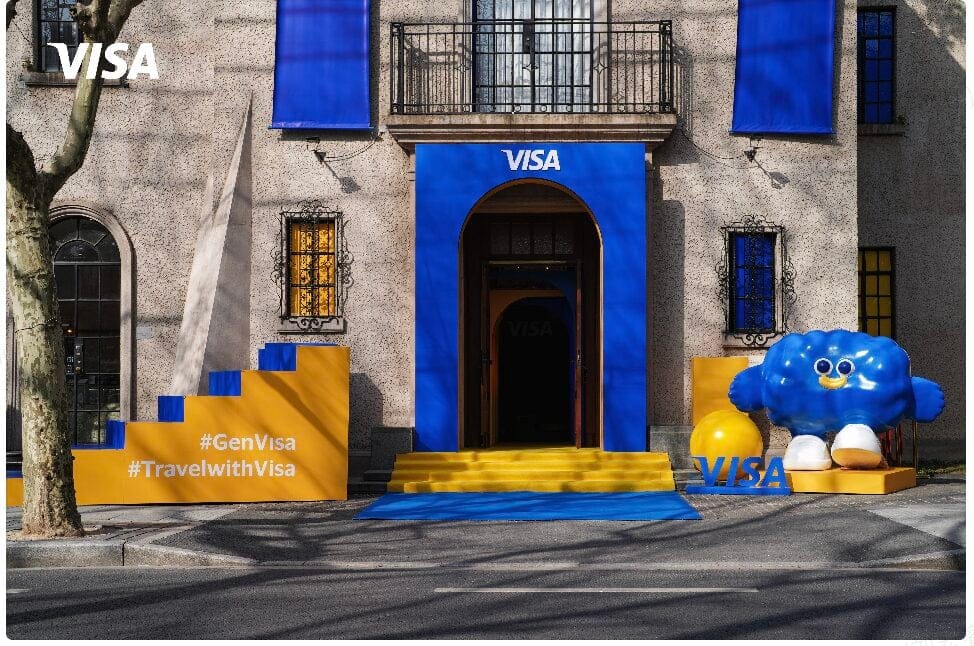Inside Visa’s Next-Gen Marketing Strategy
By
Wenzhuo Wu

Published on
March 27, 2025

Jingzhi Brand spotlights the most forward-thinking domestic and global brands shaping China’s jingzhi(精致) landscape. Through in-depth storytelling, we explore innovation, cultural strategy, and market ambition, offering a holistic perspective on the evolving intersection of brand identity and China’s dynamic consumer economy.
This March, Visa brought the Visa Cash App RB (VCARB) Formula One Team and the GenVisa Creator Summit to Shanghai, reinforcing its commitment to cultural and consumer engagement in China. The brand also marks its ninth consecutive year supporting Shanghai Fashion Week, a key platform for designers, creators, and fashion enthusiasts. As the world’s leading payments network, Visa champions the power of incremental change—where every transaction empowers China’s Gen Z to embrace their evolving identities.
Against the backdrop of China’s rapidly shifting economic landscape, Visa continues to refine its strategy, leveraging nearly four decades of market experience to stay ahead of emerging financial trends. Through data-driven insights and deeper consumer engagement, the company is positioning itself at the intersection of payments innovation and new consumer expectations.
Danielle Jin, Chief Marketing Officer at Visa Asia Pacific, shares her perspectives on the market’s trajectory, shifting consumer behaviors, and the innovations shaping the future of payments in China.

“China’s economic and social development is full of vitality,” Jin says. While much of Asia Pacific is focused on fiscal consolidation, China is taking a countercyclical approach, introducing stimulus measures that bolster spending and drive economic momentum.
Cross-border travel is also rebounding rapidly, with 610 million entry and exit trips recorded in 2024, reaching over 90 percent of 2019 levels. Visa anticipates a full recovery in 2025, with international travel demand surging.
Redefining Consumer Engagement
Understanding cultural nuances is central to Visa’s marketing approach. “Chinese consumers deeply value their heritage, and brands that acknowledge these nuances in their campaigns build stronger connections,” Jin explains in her exclusive interview with Jingzhi Chronicle. By aligning marketing efforts with key local events and traditions, Visa strengthens consumer trust.
Data is another pillar of the company’s strategy. Consumer Payment Attitude and Travel Intention Surveys help track evolving behaviors, from preferred travel destinations to spending patterns, allowing Visa to anticipate shifts and refine its offerings. Gen Z, in particular, is shaping market trends, with over 70 percent in China prioritizing personal lifestyle spending. “This generation seeks meaningful experiences over material possessions, and that shift is redefining brand engagement,” she notes.
Adapting to a Changing Travel Landscape
Understanding changes in consumer travel behaviours has been key in redefining brand engagement. “We’re seeing a shift toward slow travel, with Chinese travelers staying, on average, two days longer per trip than in 2019,” Jin observes. The Greater Bay Area alone accounts for 25 percent of intra-Asia Pacific trips, underscoring the need for seamless cross-border payments.
Engaging Gen Z also requires tapping into their diverse interests. “They don’t just have one passion—they move fluidly between fashion, music, motorsports, and gaming. We need to create experiences that feel authentic to their world.”
Blending Global Strength with Local Relevance
Visa’s global reach enables it to bring world-class innovations to China while ensuring local relevance. Sports sponsorships remain a core strategy. “Visa has long been a major partner of the Olympics and FIFA. For the 2024 Paris Olympics, we partnered with ten major Chinese issuers to launch Olympic-themed cards, generating significant engagement.”
Motorsports is another growing focus. “Formula 1 is one of the fastest-growing sports for Gen Z, with 77 percent of fans under 35. Our sponsorship of the Visa Cash App RB Formula One Team (VCARB) allows us to tap into that momentum.” A Shanghai 3D billboard activation for the team reached billions of fans, reinforcing Visa’s ability to connect with digitally savvy audiences.

Fashion, too, serves as a powerful cultural connector. Visa has a long-standing partnership with Shanghai Fashion Week, supporting emerging Chinese designers. Earlier this year, the company brought Chinese designers to Harrods London, elevating their global presence. Visa also brought over 50 digital creators across Asia Pacific to Shanghai Fashion Week in March, amplifying the impact of Chinese fashion design.
Innovations Shaping the Future of Payments
Visa is investing heavily in AI to enhance fraud prevention. “We’ve invested $3.3 billion in AI and data infrastructure to make transactions safer and more seamless.” Jin also shares “Visa Protect,” a suite of AI-powered solutions AI-powered solutions, in Luxury Through a New Lens: 2025 Jingzhi China Vision Report, published by Jingzhi Chronicle.
Public transportation is another area of focus. Visa’s Tap to Ride technology is modernizing transit systems worldwide, with over 870 contactless transit projects launched in 2024 alone, including in Beijing, Hong Kong, New York, and Singapore.
Biometric authentication is also gaining traction. “At the 2024 Singapore FinTech Festival, we announced a palm payment pilot with Tencent. The future of payment authentication will rely on biometrics—faces, fingerprints, and even palm scans—rather than traditional card numbers or passwords.”
Navigating the Chinese Market in 2025
Jin highlights three priorities for brands looking to succeed in China: agility, audience expansion, and cultural fluency. “You have to be where the consumers are. Gen Z, in particular, isn’t confined to a single passion. They’re engaged across sports, gaming, fashion, and music, and brands must meet them at all these touchpoints.”
Expanding to new audience segments is equally critical. “You can’t just rely on your traditional customer base. The future belongs to brands that can adapt and build relationships with the next generation.”

Speed is also essential. “China moves fast. If you hesitate, the opportunity is gone. The brands that thrive here are the ones that act decisively.”
Looking ahead, Visa is committed to deepening its engagement with Chinese consumers. “Our major sponsorships and activations in sports, fashion, and gaming will continue to reinforce our presence in key cultural moments. At the same time, we’re investing in personalized, experiential marketing strategies to enhance benefits for travelers, students, and outbound consumers.”
As China’s market continues to evolve, Visa’s strategy remains clear: “We want to empower consumers by integrating payments with the passions, experiences, and lifestyles that define the future of spending. It’s about being more than a payment network—it’s about being a partner in the moments that matter most.”












